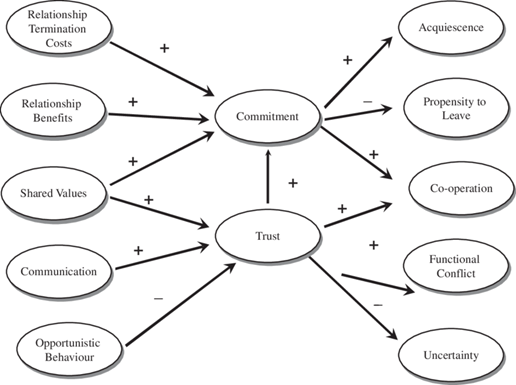It should come as no surprise that marketers and professionals alike are being forced to reassess the development of their client relationships. The coronavirus pandemic accelerated the inevitable entry into a virtual world, and remote and hybrid working environments are only becoming more popular as the post-pandemic world evolves.
When it comes to relationship development, there are certainly disadvantages to increased virtual engagements. However, there are many advantages to the speed and efficiency at which we can work in this new environment. Engagement with our global clients has never been more accessible. Companies now have the capabilities to instantly provide deep insight and sneak peaks into a project for their clients with the click of a “share” button. With an increase in virtual engagements, it is imminent to consider the advantages and disadvantages of this new working environment and analyze how the variables of relationship marketing change in virtual engagements, so that we may keep relationship marketing success top of mind.
What is Relationship Marketing?
So, what is relationship marketing? Relationship marketing prioritizes the loyalty and the retention of a customer over a specific transaction. It consists of the efforts that go into making a customer happy and maintaining successful exchanges.
What constitutes successful relationship marketing? Well, one would likely argue that a long-term favorable relationship, where both parties benefit, is a result of successful relationship marketing.
In 1994, Robert M. Morgan and Shelby D. Hunt published their theory on relationship marketing that revolved around two key mediating variables—commitment & trust. This paper, “analyzes the variables that affect relationships and argues that commitment and trust are mediating variables required for relationship marketing success.
Their KMV (Key Mediating Variable Model) demonstrates how precursor variables impact relationship commitment and trust. From there, the resulting levels of commitment and trust impact the outcome variables on the right side of the diagram.

Precursor Variables
The precursor variables of the KMV Model consist of the following:
- Relationship Termination Costs – How costly or inconvenient would it be for a client to terminate their engagement with you?
- Relationship Benefits – How does the client benefit from working with you? This could manifest in a number of ways, including exceptional quality of work, fancy dinners or trips, or even friendship.
- Shared Values – Does the client or the client company share values with you or your company? These values could regard the work they produce or how they operate and treat each other internally.
- Communication – What is the client’s communication style? Consider frequency, tone, power levels, etc.
- Opportunistic behavior – Do you consistently engage in opportunistic behavior? Are you often seeking more money or better connections? And vice versa.
Key Mediating Variables
In the KMV Model, Commitment and Trust are the mediating variables. They are affected by the precursor variables and their increase or decrease then affects the outcome variables. It is important to note that commitment and trust do not always positively correlate with the precursor variables or the outcome variables.
For example, shared values do have a positive correlation with commitment and trust. As shared values increase, so do commitment and trust.
However, opportunistic behavior does not have a positive correlation with commitment and trust. If opportunistic behavior increases, commitment and trust decrease.
Outcome Variables
Changes in commitment and trust positively or negatively correlate with the following variables:
- Acquiescence – Does the client accept or submit to your recommendations without protest?
- Propensity to Leave –How likely is the client to end the engagement?
- Cooperation – Does the client cooperate with you and your team? Are they pleasant to work with? Or do they consistently give pushback?
- Functional Conflict – When there is conflict, does it lead to a productive outcome? Sometimes conflict can be good. No one wants a client who constantly agrees or doesn’t provide feedback. This can lead to dissatisfaction later in the engagement; however, the appropriate presentation of their concern or their feedback leads to positive action.
- Uncertainty –Do you or the client feel uncertain in regard to where the project or the relationship are headed?
It is crucial to note that in a virtual or in-person relationship, the variables themselves do not change in this model. The precursor variables will always positively or negatively impact commitment and trust and commitment and trust will, in turn, positively or negatively impact the outcome variables.
What may change in a virtual engagement is the specific character or activities involved in each precursor variable and the relative weight of that these variables have on the commitment and trust in the relationship.
Use Cases
Let’s analyze how an in-person relationship and a virtual relationship may differ. For the sake of this article, let’s say you have one client (Client A) who you frequently see in-person. You may email back and forth or talk on the phone once or twice a week, but your primary decision-making engagements are held in-person.
Your second client (Client B) is located on the other side of the country. Just like Client A, you may email and talk on the phone frequently with Client B; however, you have never had an in-person engagement with Client B. All of your primary decision-making engagements are held on video calls.
Shared Values
The precursor variables will always exist in each relationship, but the dynamic of each variable will differ across the two examples. With Client A, shared values are very important on a personal level. You frequently see each other in-person and about one-third of your interaction is non-work related. You may discuss your family or local events in between business discussion.
On the other hand, your small talk with Client B is limited to the first few minutes of your weekly Zoom call. It doesn’t feel as important that you connect closely on a personal level; however, Client B’s company really values differentiation. They decided to work with you because your company also shares the value of differentiation in the market. In this example, shared values positively increase both the commitment and the trust in your client relationships, but the dynamic in which the variable presents itself is different.
Opportunistic Behavior
The weight of the precursor variables on client relationships will also differ between in-person and virtual engagements. For client A, opportunistic behavior from you may not have a heavy weight, as discussing new verticals within your company and how it may relate to their business comes up organically in discussion. When the client is walking through your office during a visit, you may explain the layout and team groupings and you may naturally mention a new product or service offering.
For Client B, opportunistic behavior from you may have a more negative weight on their trust than Client A. Client B’s perception of the internal dynamic of your company is limited to the context they gage from video calls and any preexisting context from sales and onboarding conversations. Mentioning new products of service offerings will be perceived more negatively than the organic mention with client A. This will have a greater weight on the trust you have with Client B.
Conclusion
To see technology evolving in the workspace is not new; however, we have experienced a rapid succession into a much more virtual working environment and that has changed the way that we work. Client relationships are essential to the strength and retention of our business. The relationships we hold speak to who we are as people and organizations, so we must keep relationship marketing top of mind as our engagements evolve.
In 1994, Morgan & Hunt likely could not picture their model being used in a virtual working environment, but “The Commitment-Trust Theory of Relationship Marketing” is relevant today. By analyzing how our newfound environment effects the dynamic and weight of each variable in this model, we can continue to work towards relationship marketing success.
